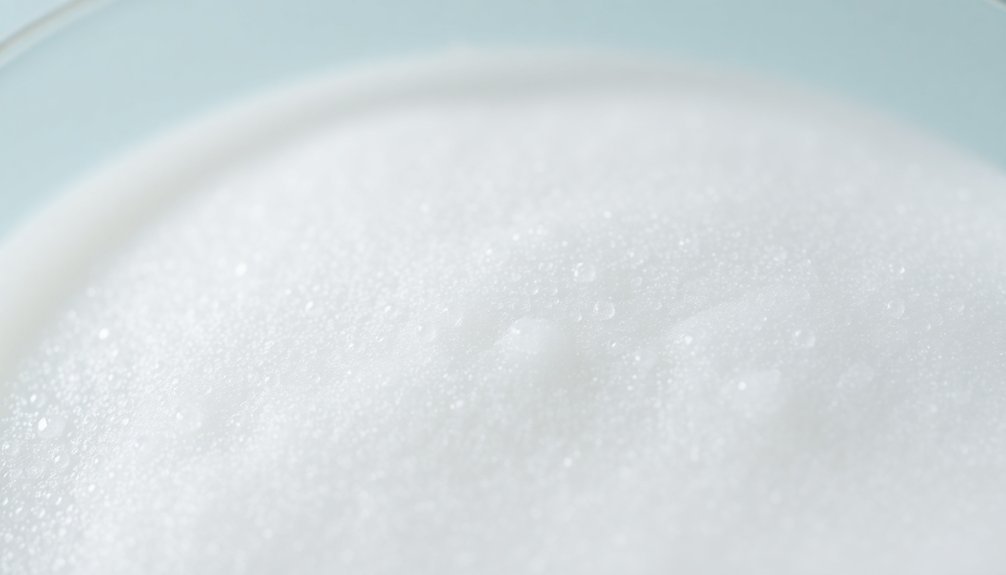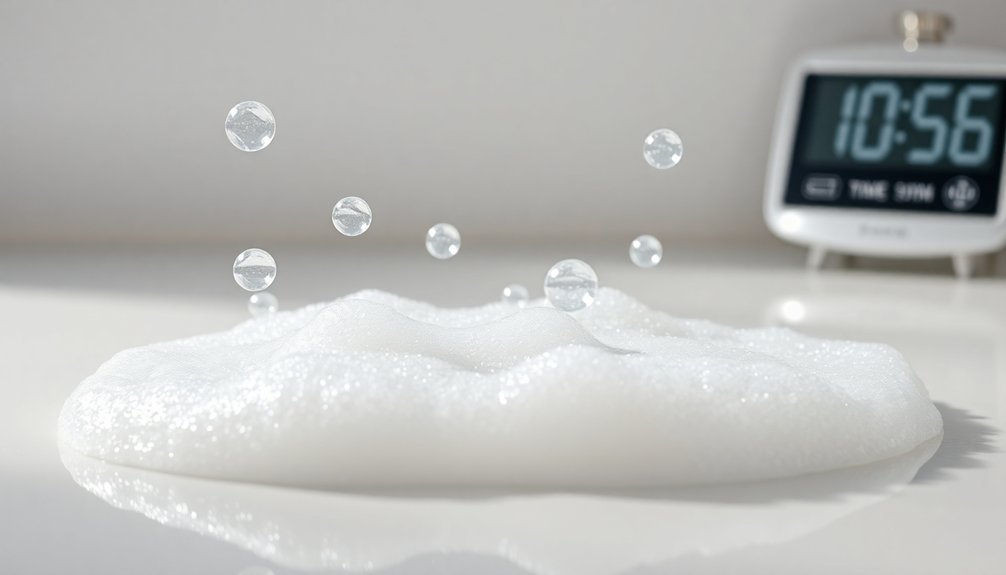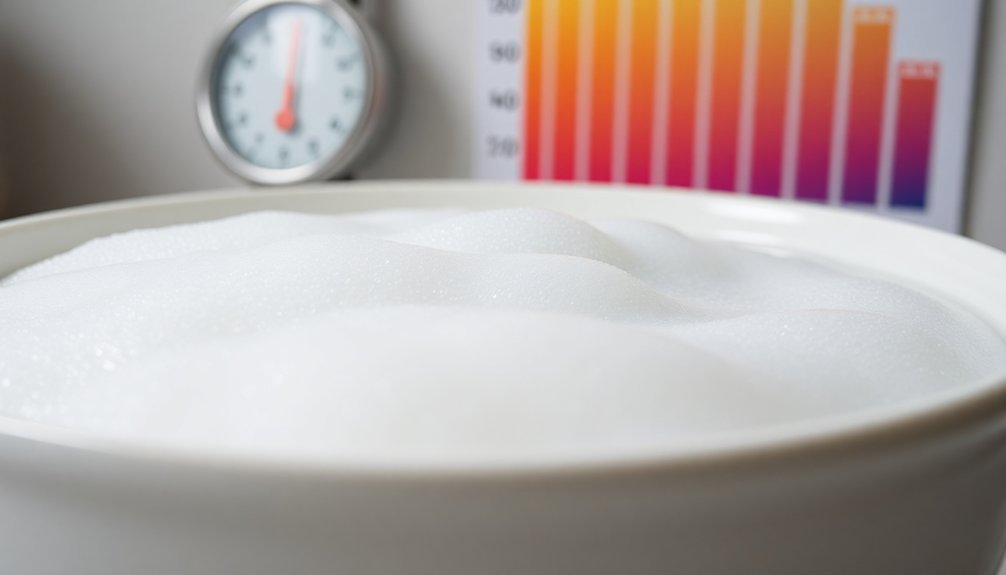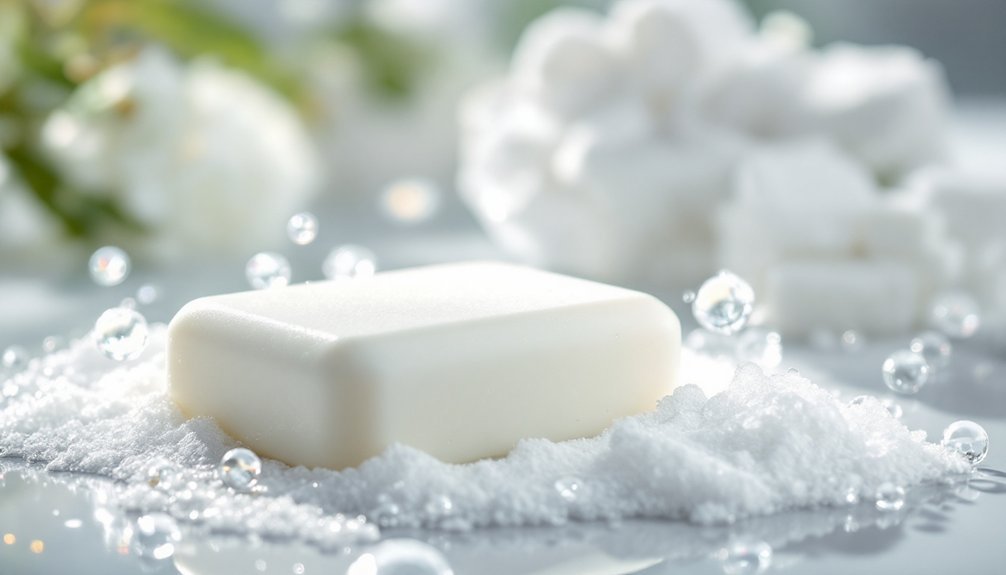The 5 best methods to test lather quality include the Quick Absorption Test (applying water drops to soap surface), Water Hardness Analysis (using electronic testers), Timer-Based Foam Persistence tests (measuring stability duration), Visual Inspection of bubble size and density, and Temperature Variation Testing (evaluating performance at different temperatures). You'll need consistent testing conditions and proper equipment for accurate results. These techniques will help you distinguish superior soaps and optimize your lathering experience with scientific precision.
The Quick Absorption Test: Measuring Lather's Texture and Stability

When evaluating soap quality, the quick absorption test provides valuable insights into both texture and stability of the lather. This simple test requires applying a small amount of water to assess whether it beads on the surface or absorbs into the material.
The test typically takes only a few minutes and reveals critical properties about your soap's performance. If the lather maintains its bubbles and structure, it demonstrates good stability. You should apply one or two drops with a spoon or finger to achieve the most accurate assessment.
A quality soap reveals itself in minutes—stable bubbles and structured lather indicate superior performance.
Water hardness can greatly affect texture results, so consider testing in conditions similar to where you'll use the product.
While primarily designed for soaps and detergents, this test offers practical guidance for product selection. For accurate results, verify the testing area is clean and undamaged.
The stability of your lather directly correlates with the overall quality and performance of the soap.
Advanced Water Hardness Analysis for Lather Consistency
Although many soap enthusiasts focus on ingredients and fragrance, water hardness greatly impacts your lather quality regardless of soap quality. Understanding your water's mineral content provides valuable insight into why your favorite soap performs differently in various locations. Regular water hardness monitoring helps maintain plumbing system integrity by preventing limescale build-up in pipes and fixtures.
| Testing Method | Accuracy | Cost |
|---|---|---|
| Soap Test | Low | $ |
| Electronic Tester | High | $$$ |
| Chemistry Kit | Medium | $$ |
For precise measurements, use an electronic tester that measures conductivity to determine mineral content. Look for readings above 3 gpg (grains per gallon), which indicate hardness levels that will affect lather performance. Alternatively, test with castile soap—quick, stable bubbles indicate soft water, while slow lathering or scum formation reveals harder conditions. You'll need more soap product and effort to achieve the same lather quality in hard water regions.
Timer-Based Foam Persistence Evaluation

Timer-based foam persistence represents the most objective measure of lather quality once you've addressed water hardness concerns. This method quantifies how long your product's lather remains stable after air introduction stops—a critical factor for consumer satisfaction in personal care products.
You'll need graduated cylinders, sparger tubes, gas flow meters, and precise timers to conduct these evaluations properly. Control air flow rates carefully, as higher rates can create excessive foam that skews results. Conducting tests that mimic conditions found in actual usage scenarios will yield the most valid and applicable results.
- Use consistent temperature conditions as heat considerably impacts foam formation
- Record both initial liquid levels and maximum foam heights for accurate comparison
- Employ ANOVA analysis to determine statistical importance between test conditions
- Maintain identical sample preparation techniques to guarantee repeatability
- Consider using specialized equipment like the DFA100 for more precise measurements
Visual Inspection of Lather Bubble Size and Density
Visual inspection of lather provides critical qualitative data that complements the quantitative metrics from timer-based evaluations.
Visual assessment of soap lather yields essential qualitative insights that enhance timer-based quantitative measurements.
You'll need consistent testing conditions—warm water and standardized soap quantities—to achieve reliable results.
When examining lather, look for both bubble size variation and overall density. Small, uniform bubbles typically indicate a premium product, while larger, inconsistent bubbles may suggest formulation issues.
Hold your soap sample against a neutral background and use proper lighting to minimize glare and enhance contrast. Similar to leather inspection, reflective surfaces can create uneven lighting conditions, hindering accurate visual assessment.
For best results, establish a standardized rubbing sequence that you'll use across all samples.
As you compare different soaps, note differences in texture, persistence, and how quickly the lather builds.
This visual assessment, when documented properly, provides valuable feedback for refining your formulations.
Temperature Variation Testing for Optimal Lather Performance

Temperature variation testing represents one of the most revealing methods for evaluating lather quality, as it directly affects surfactant performance and bubble stability.
You'll want to establish a consistent baseline temperature before gradually increasing water temperature to identify the sweet spot for your soap formulation, typically between 30-40°C.
- Start with room temperature water to establish your baseline measurements
- Use a water bath with precise temperature control to guarantee consistent testing conditions
- Monitor how your lather changes at 5°C increments as you increase temperature
- Document when lather reaches peak volume and stability, then when it begins to deteriorate
- Consider how water hardness interacts with temperature—harder water may require different ideal temperatures
For accurate results, maintain a heating rate of 2°C per minute as excessive heating speeds can produce unreliable measurements similar to leather shrinkage temperature testing.
Frequently Asked Questions
How Does Skin Type Affect Lather Quality Testing Results?
Your skin type directly impacts lather tests – oily skin creates enhanced lather, dry skin produces less, and sensitive skin may react differently. You'll get more accurate results by adjusting products to your specific skin needs.
Can Professional Lathering Tools Improve Test Accuracy?
Yes, professional tools improve accuracy through standardized testing environments. You'll achieve more consistent results with specialized equipment that controls water hardness, temperature, and application pressure, eliminating many variables that affect lather evaluation.
Do Natural vs. Synthetic Materials Create Different Lather Patterns?
Yes, you'll notice natural soaps produce softer, airy lather with larger bubbles, while synthetic materials create denser, consistent foam with finer bubbles. Natural lathers vary based on ingredients, while synthetic ones maintain uniform patterns.
What Role Does Product Age Play in Lather Quality?
As your soap ages, you'll notice improved lather quality. The curing process removes moisture, creating harder, more efficient soap. While scents may fade over time, your natural soap's lathering ability actually improves with age.
How Do Scented Additives Impact Lather Stability Testing?
When you're testing lather stability, scented additives can interact with lather-forming ingredients, potentially altering results. You'll need to maintain consistent fragrance levels across batches to properly evaluate how these additives affect your soap's performance.
In Summary
Now you're equipped with five scientific methods to evaluate your soap's lather quality. Whether you're testing absorption speed, measuring water hardness effects, timing foam persistence, examining bubble structure, or experimenting with temperature variations, you'll gain valuable insights into performance. Apply these techniques consistently to compare products effectively and identify the perfect formula for your needs. Remember, quality lather isn't just about aesthetics—it's about cleansing efficacy and user experience.





Leave a Reply